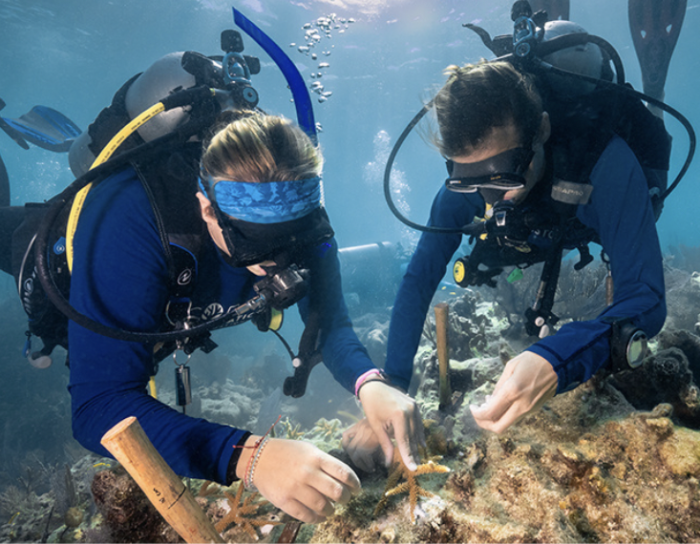
Coral: Plant or Animal?

A coral reef in Florida Keys National Marine Sanctuary. Photo credit: Greg McFall
Corals come in many shapes, sizes, and colors. They can be found across the sanctuary system, including in Florida Keys, Gray’s Reef, and Flower Garden Banks National Marine Sanctuaries. Corals build large and diverse ecological communities throughout the global ocean, earning them the nickname, “Rainforests of the Sea”. They also attract tourists, capture the human imagination, and serve as the backdrop for stories we love about fish and other marine wildlife. All of this may lead you to believe corals are plants, rather than animals. If you are surprised to learn that corals are in fact animals, read on to see what makes them so!
People often mistake corals for marine plants – or even rocks! This is because corals attach to the seafloor, can have hardened surfaces or features that make them look like terrestrial plants, and they don’t have obvious features like eyes or mouths that would suggest that they are animals. Unlike rocks and other geological features, corals are living, and unlike plants, corals themselves are not able to photosynthesize to make their own food. Corals meet all five criteria that define animals: multicellularity, consuming other organisms for food, has an internal digestive tract, embryonic development as part of the lifespan, and motility or independent movement.
So, what kind of animal are corals? They are cnidarians, a phylum of aquatic invertebrates that include anemones, hydrozoans, and jellyfish. These animals lack a true spine, have radial symmetry, and have stinging cells that help them stun and capture their prey. While corals may look like larger individuals, they are comprised of thousands of smaller polyps, each of which can be as small as a pencil tip to as much as a foot in diameter. Polyps, which look like anemones, come together to form coral colonies – when you’re looking at a single coral colony you are actually looking at thousands of animals! Corals can be soft-tissued or hard-tissued. As you might guess from the names, hard coral polyps form calcium carbonate skeletons, contributing to the deposits that attach corals to fixed structures and subsequently build up reefs overall. Soft coral polyps are held together by a jelly-like mesoglea. Corals can come in a variety of forms that resemble tree branches, brains, or fans.
Corals are most abundant in shallow, coastal waters that are warmer and receive the most light from the surface, though there are species of coral that can survive in deeper, colder, and darker waters. Hard or stony corals are unique in that they are animals that provide shelter for marine plants called zooxanthellae, a type of algae. These algae and their larger coral hosts have a symbiotic or mutually beneficial relationship. Since corals are sessile (immobile) in adulthood, they can only feed on small prey that come close enough. This makes for an uncertain dietary source. In exchange for shelter in the coral’s tissue and a guaranteed proximity to light, the algae provide corals with a steady supply of nutrients. Approximately 90% of their energy comes from zooxanthellae! The metabolic waste corals produce serves as a sort of fertilizer for the algae to use in photosynthesis, which creates a positive feedback loop for both organisms. Deep sea corals do not host zooxanthellae and corals in shallow waters can live for about two weeks without their algal residents. Corals get their color from fluorescent pigments and the pigments of zooxanthellae.
Warming waters, a more acidic ocean, and disease can all lead to a phenomenon called bleaching. Bleached corals are those whose algal residents have left their host due to conditions in which they cannot live. As a result, coral colonies lose their color and become white in color and rough in texture due to their exposed limestone skeletons. Bleached corals are not necessarily dead but are more susceptible to disease and other stressors, making death a more likely end result. Luckily, there are conservation efforts, like Mission: Iconic Reefs, underway to understand and proactively address coral bleaching events worldwide and help restore coral reefs. Some of these efforts include selective breeding of coral species to be more resilient to heat and other stressors, long-term monitoring of reefs to address bleaching events early, and caring for coral species in a controlled laboratory setting before replanting them to help colonies recover after a bleaching or disease event. Larger scale actions like addressing carbon outputs and physical and chemical pollution are also needed to protect corals and the incredibly rich ecosystems they support.

Divers outplanting cpral in the Florida Keys as part of Mission: Iconic Reefs. Photo credit: Alexander Neufeld/ Coral Restoration Foundation
